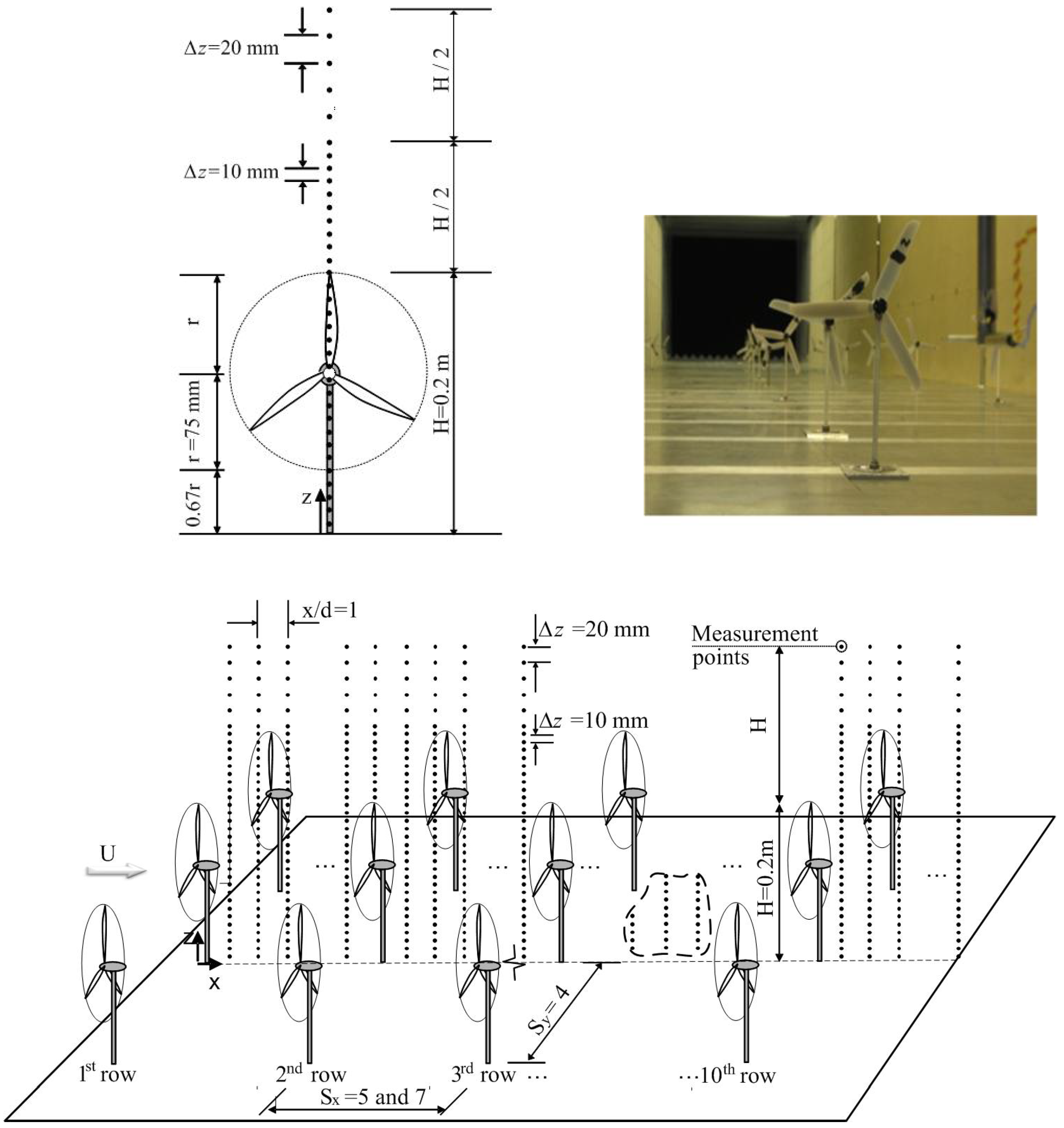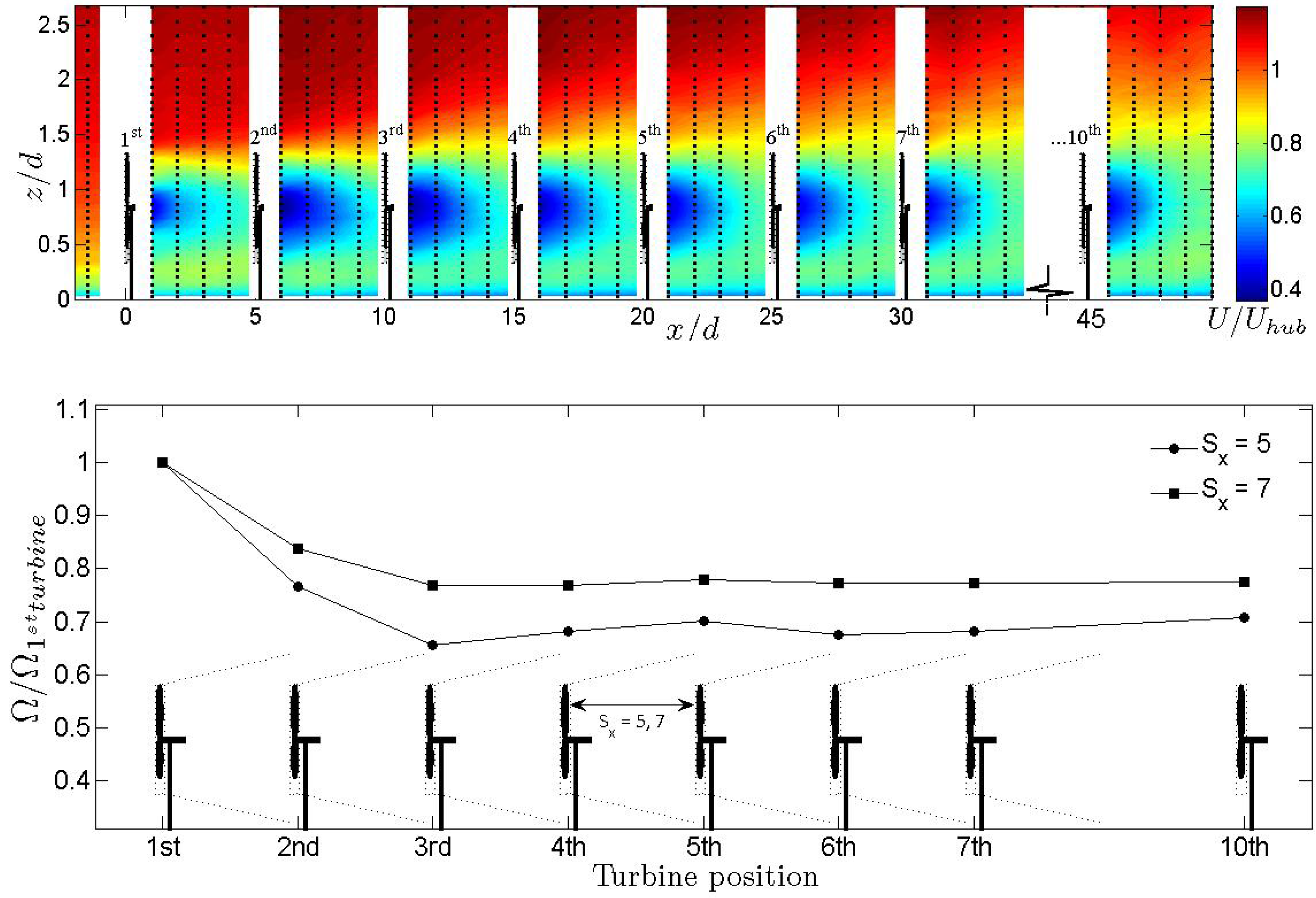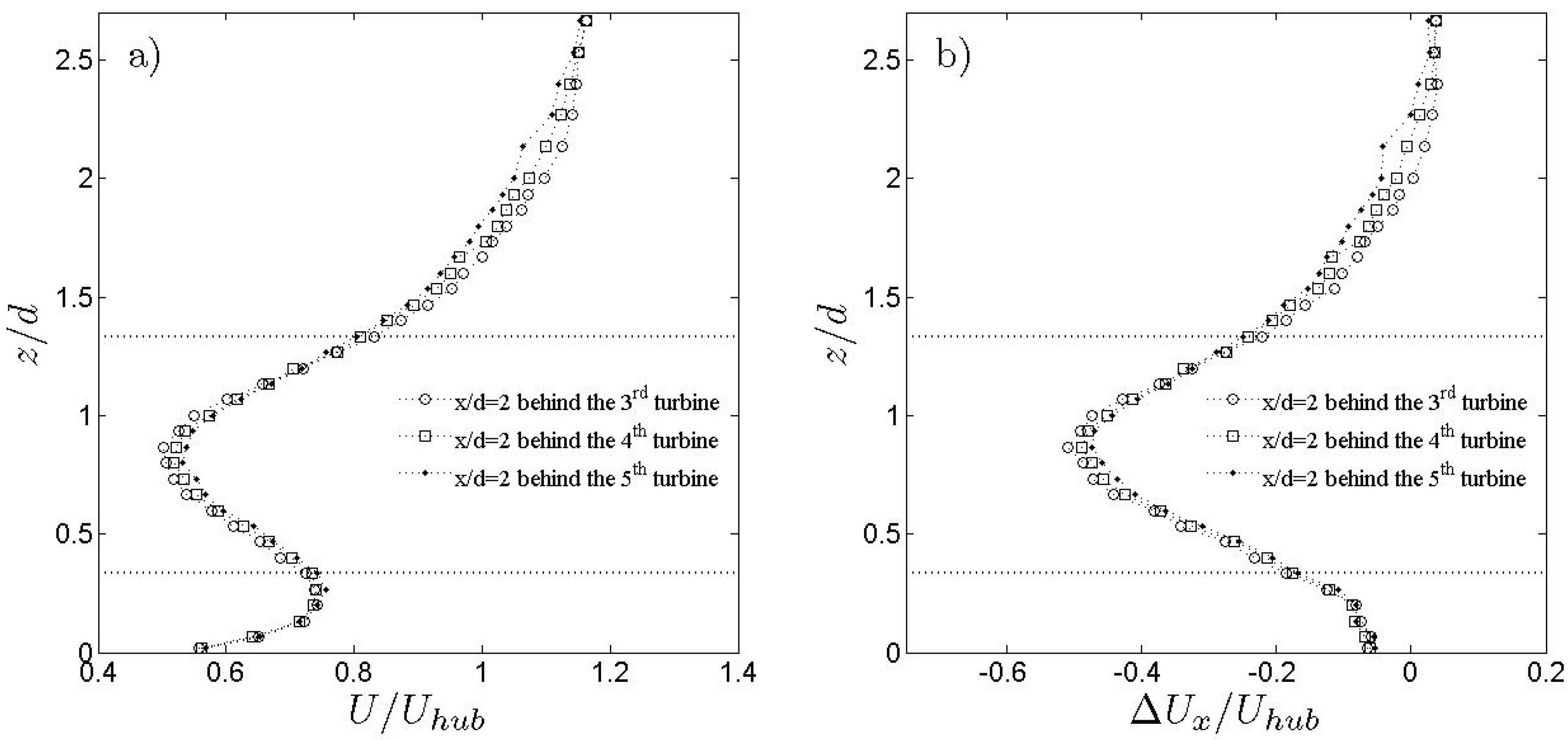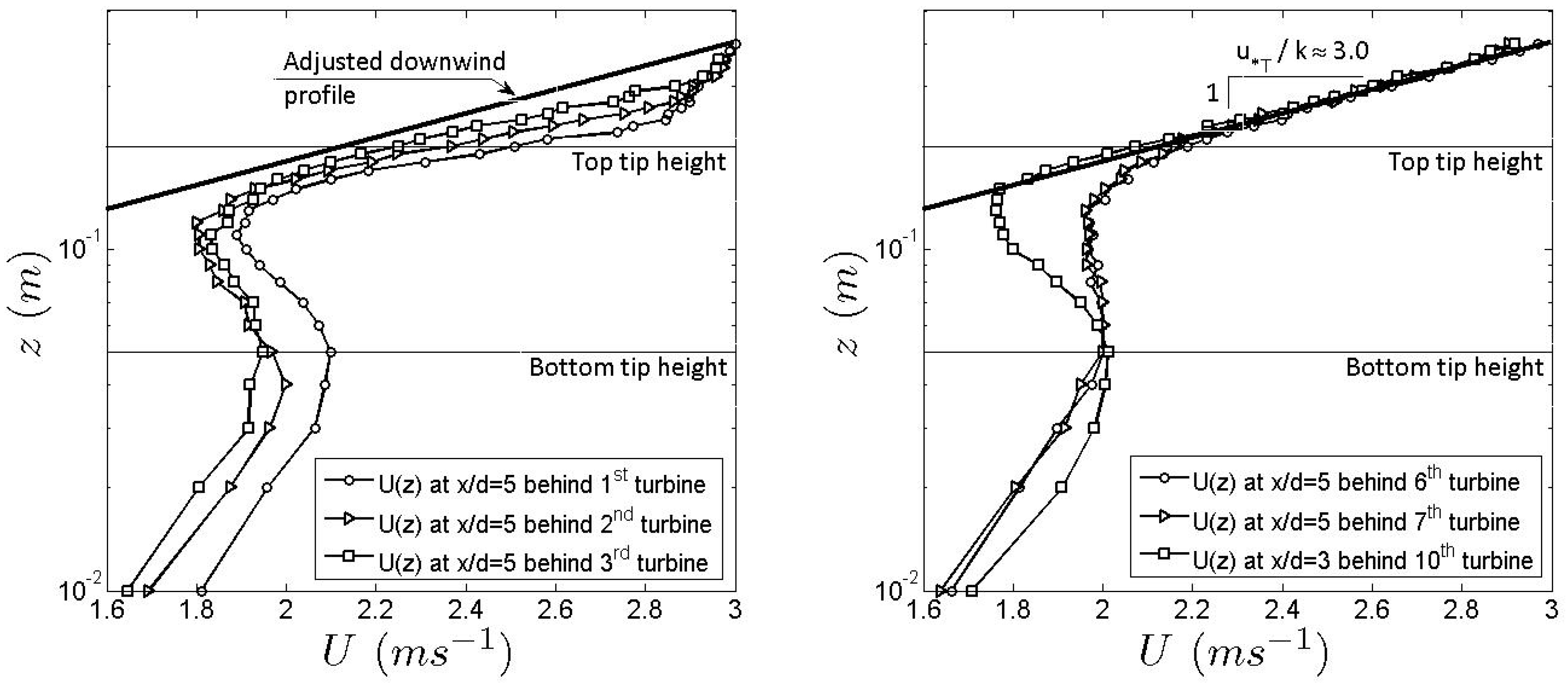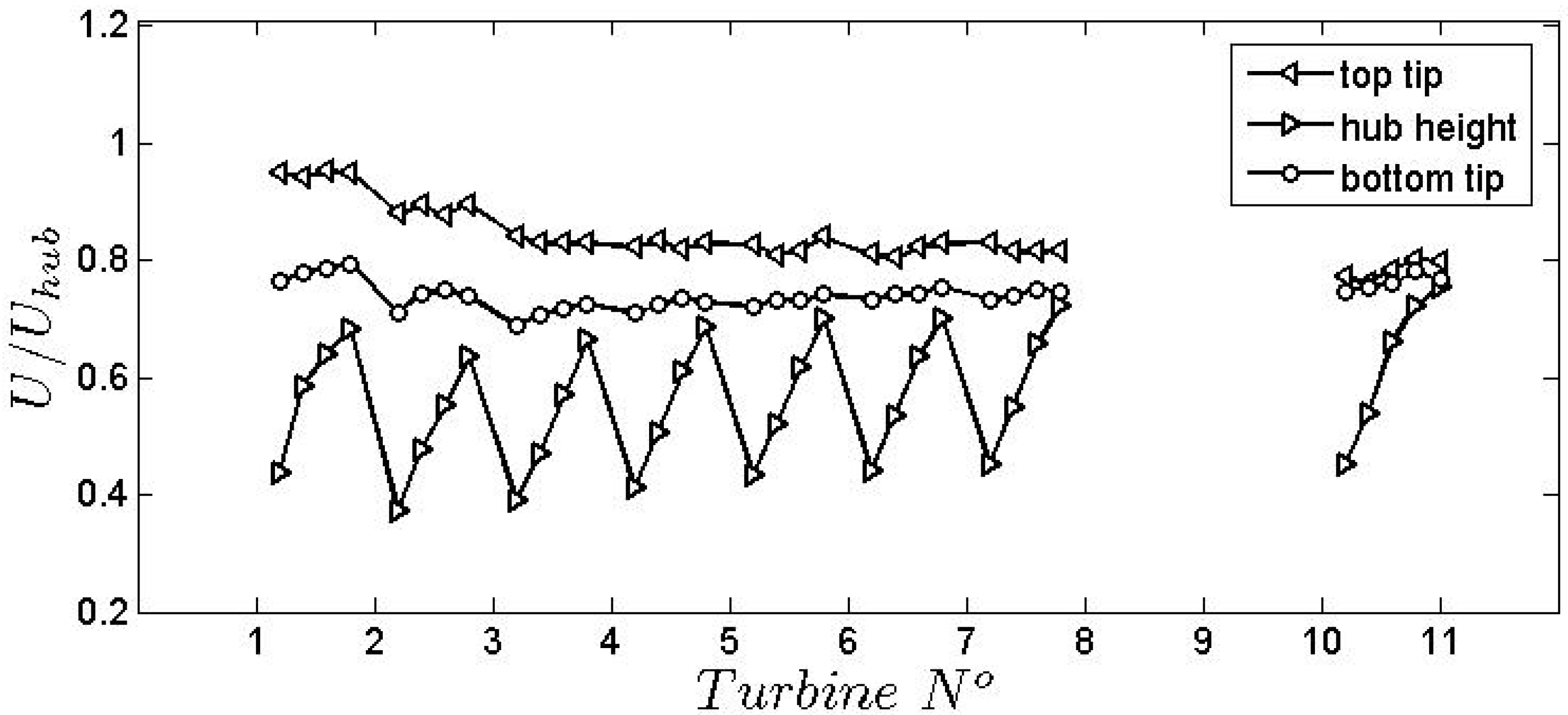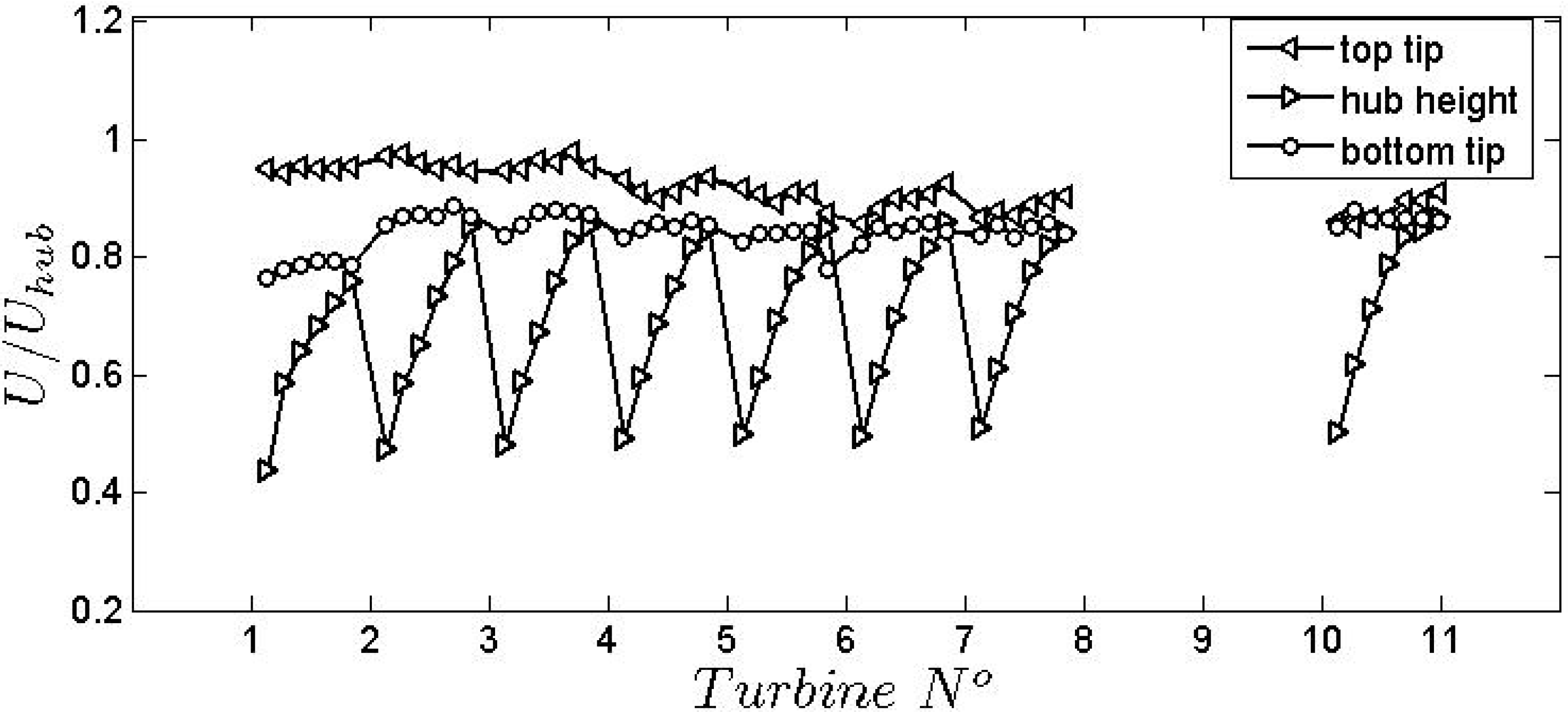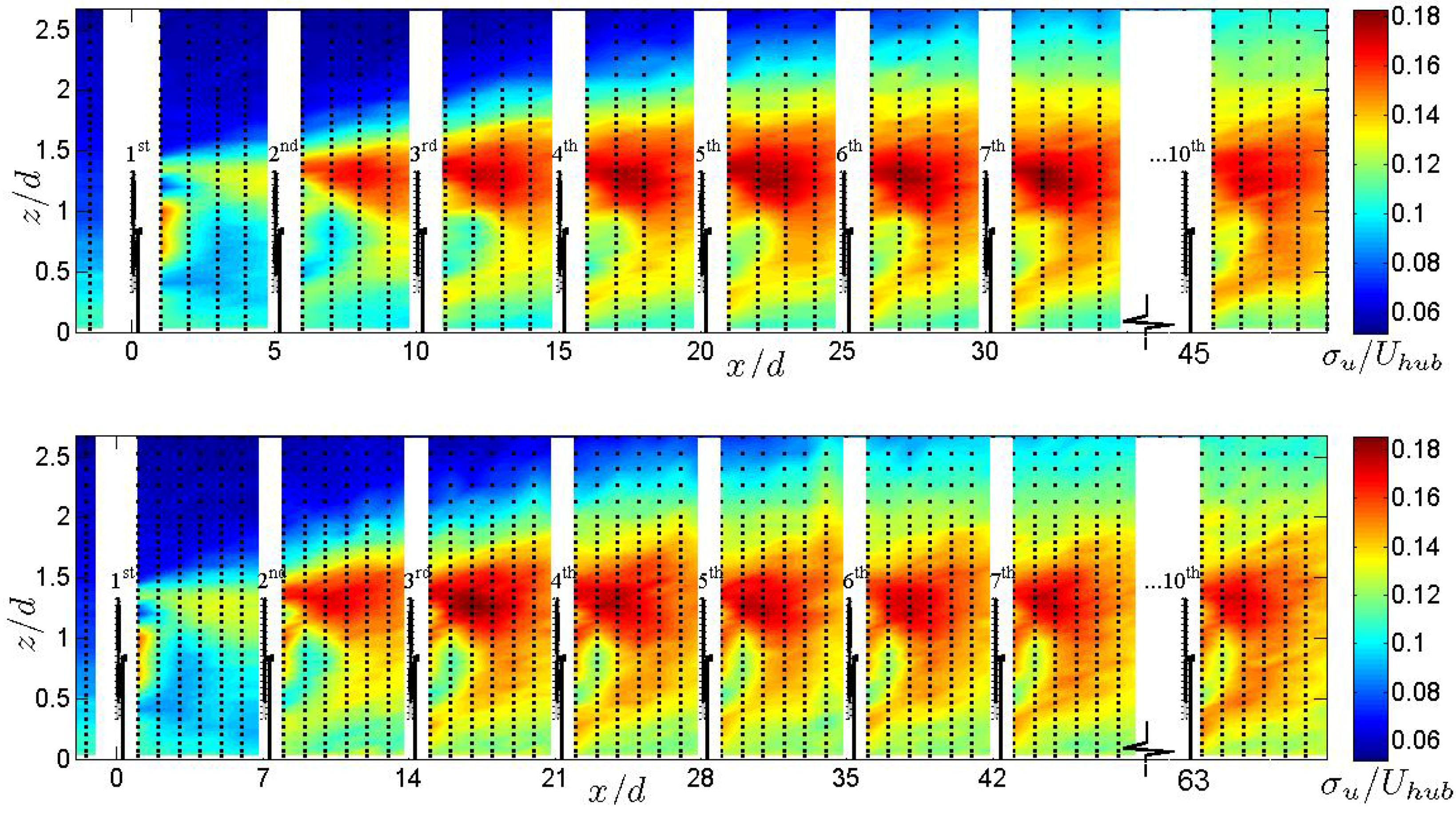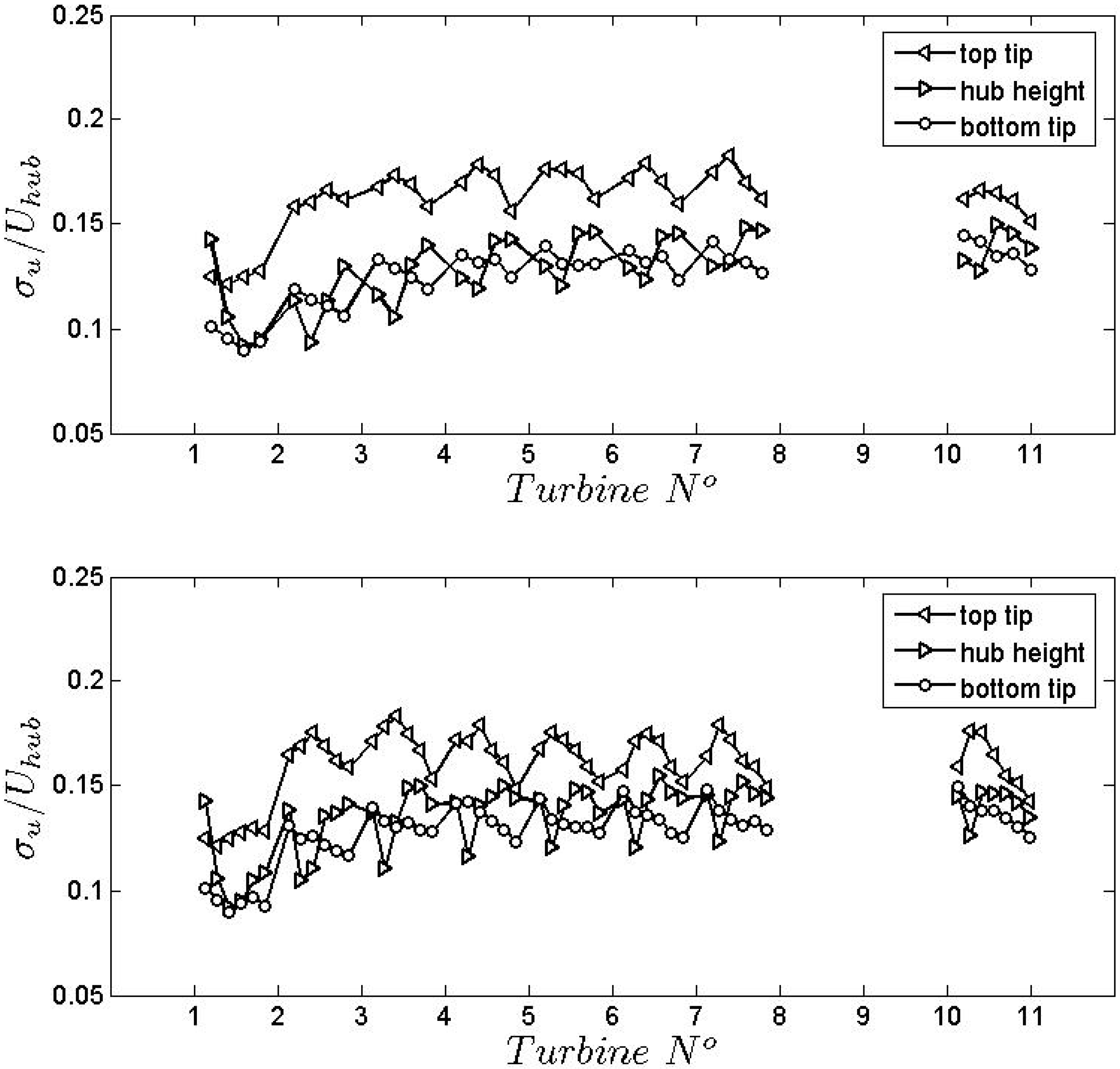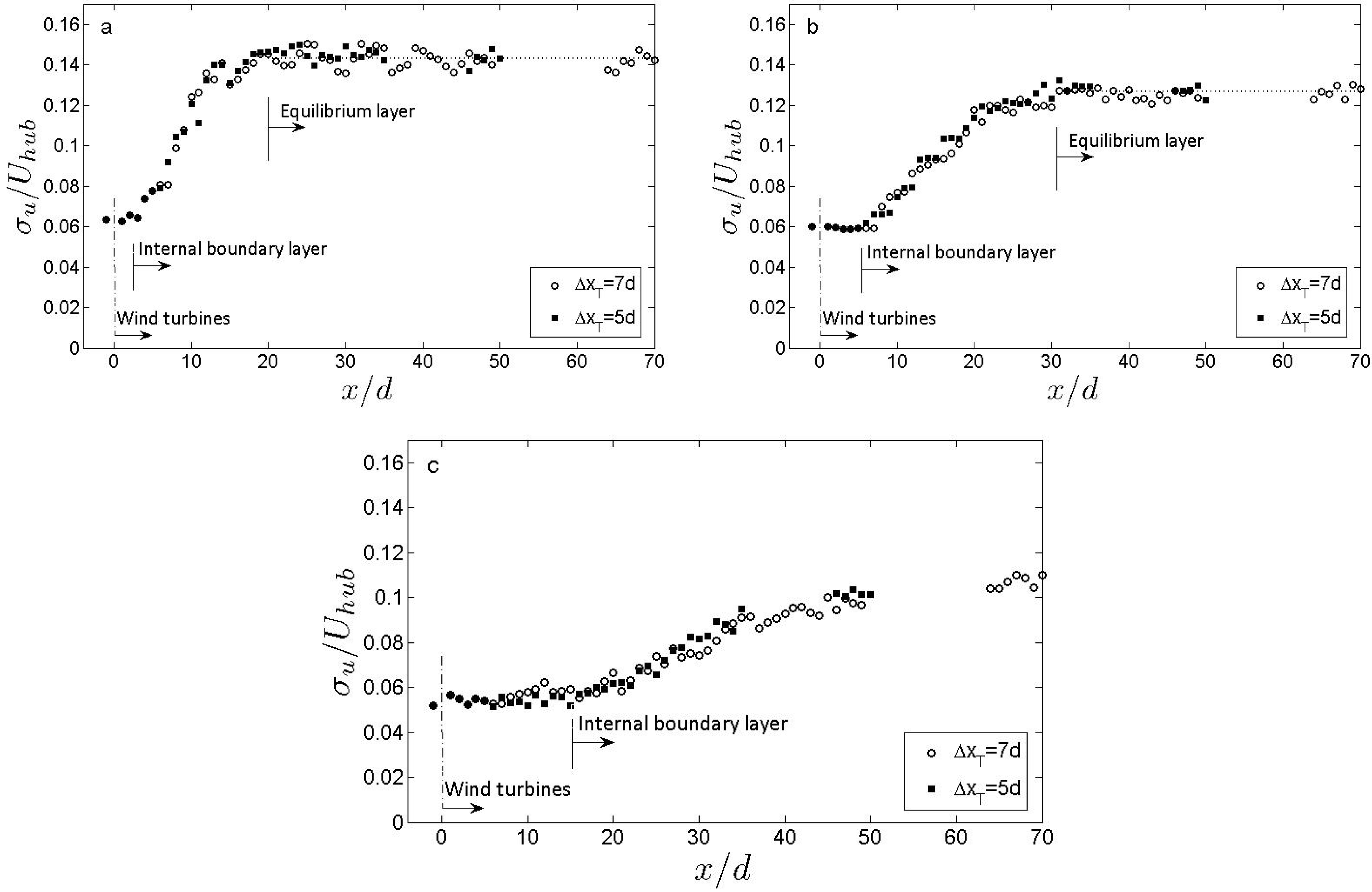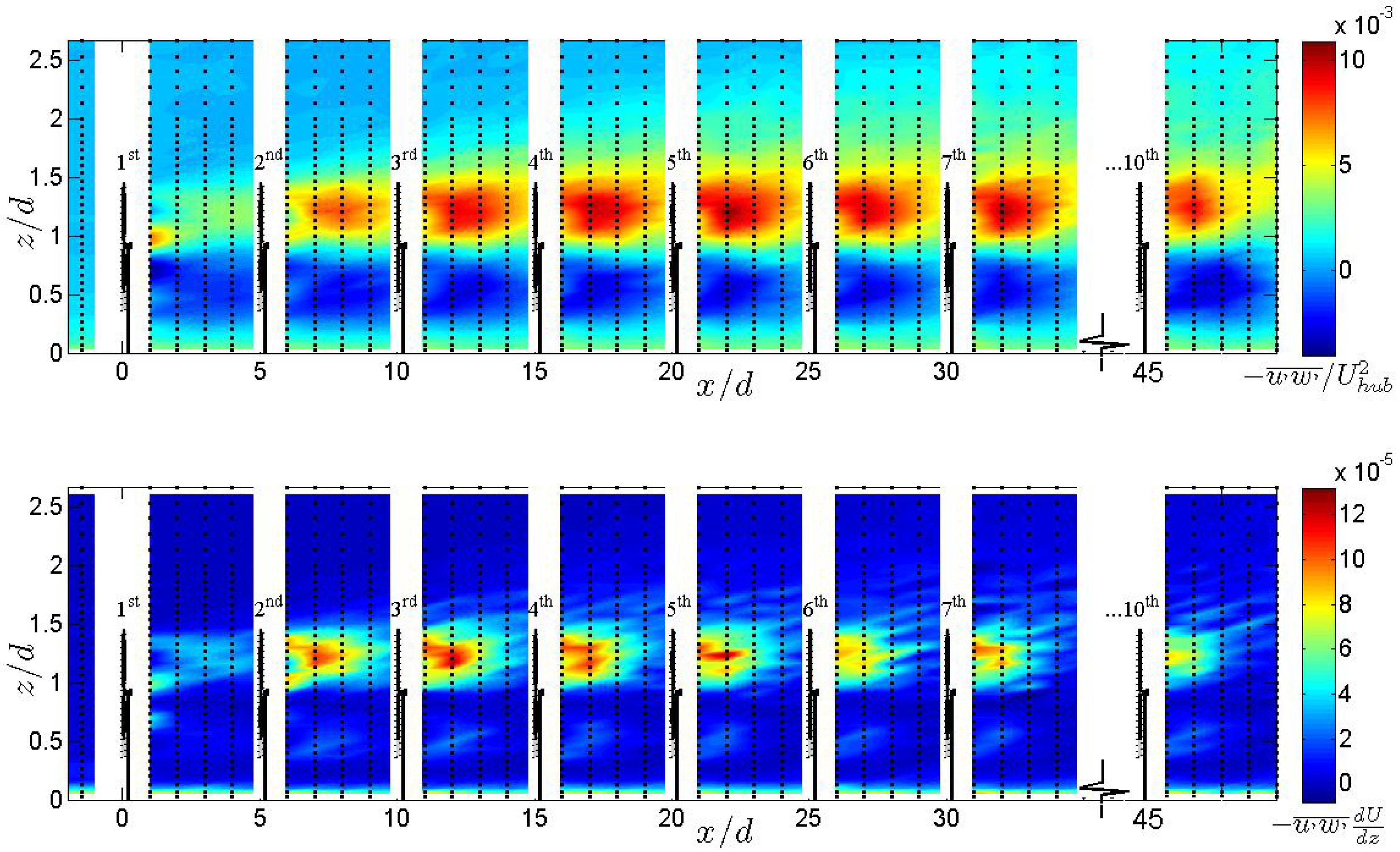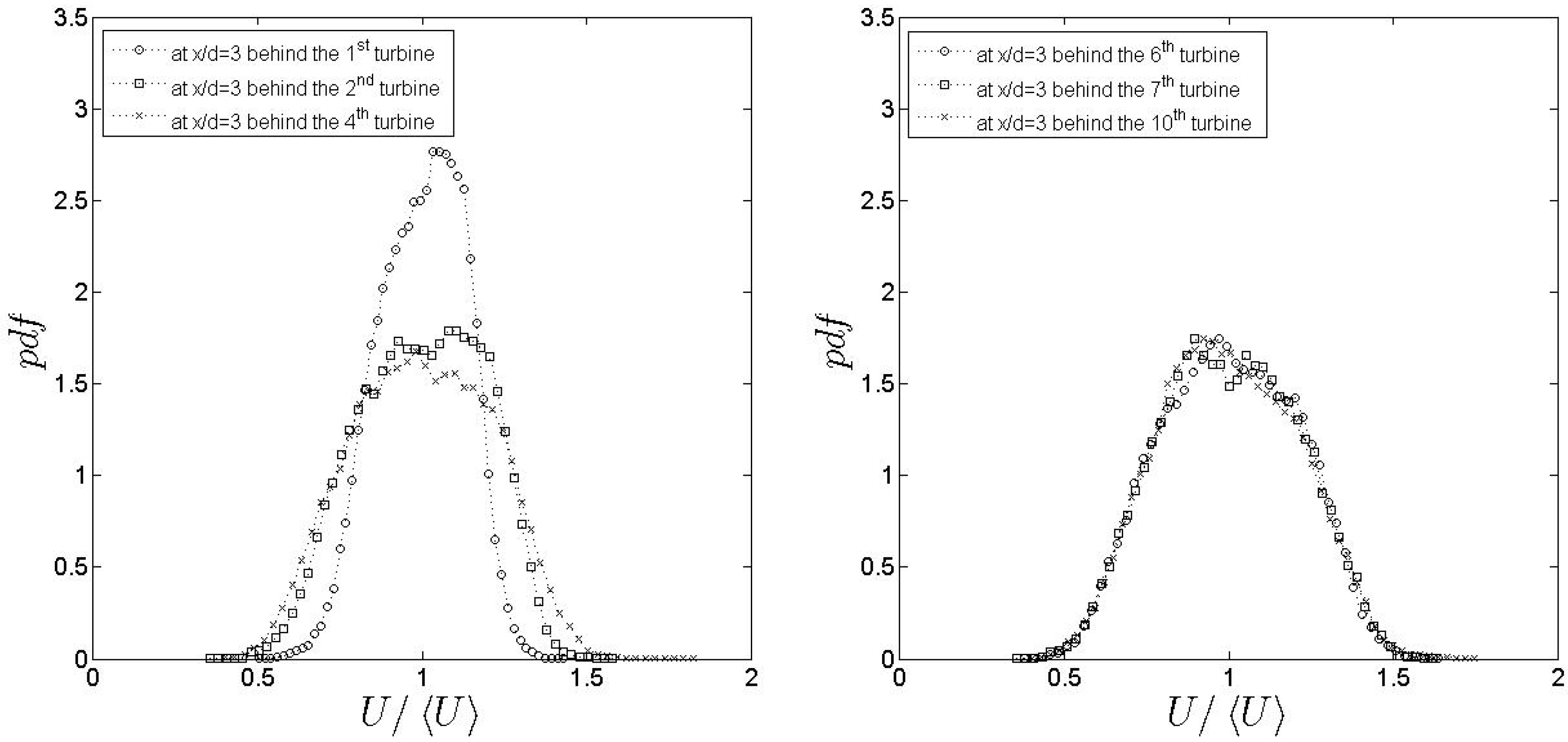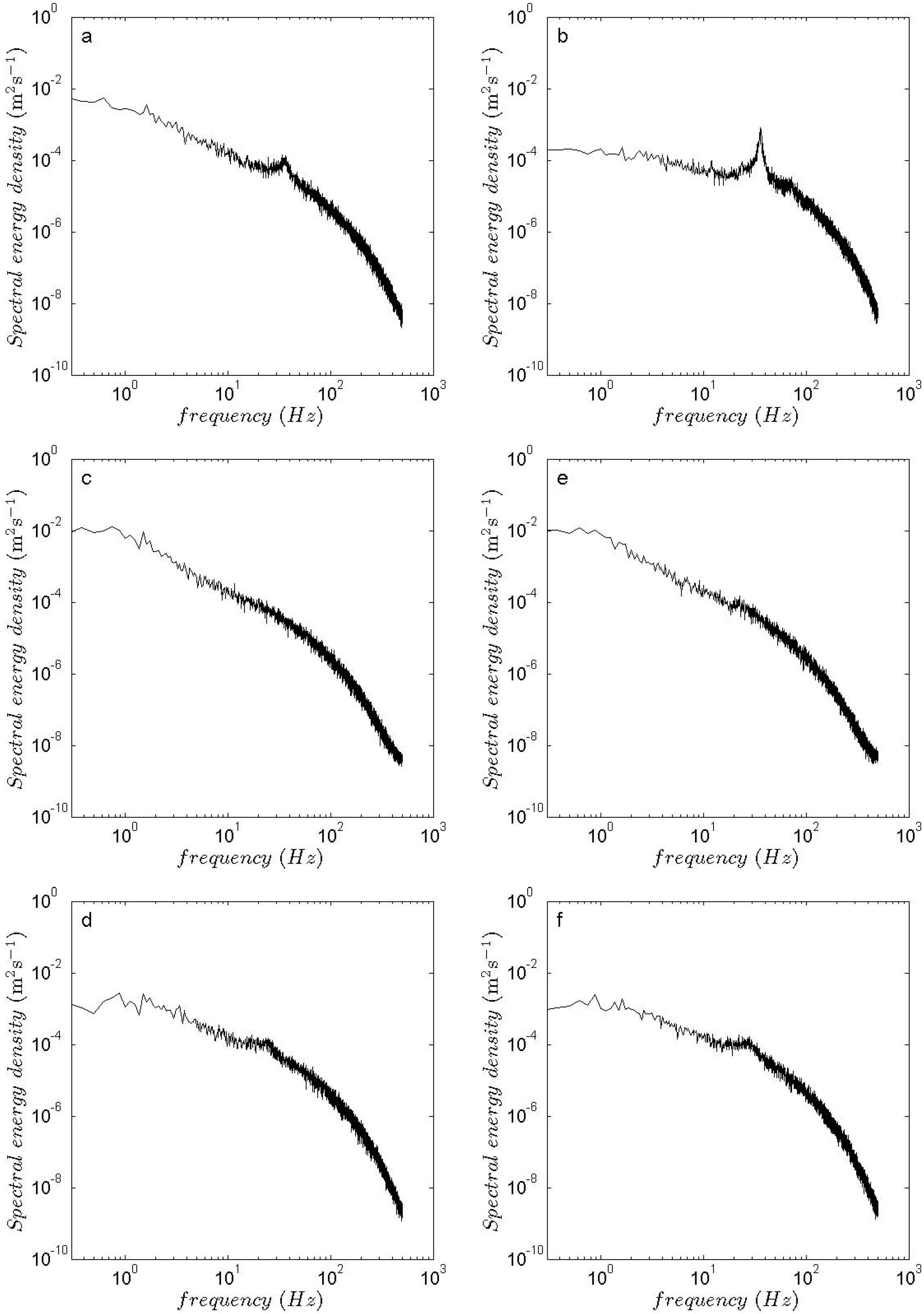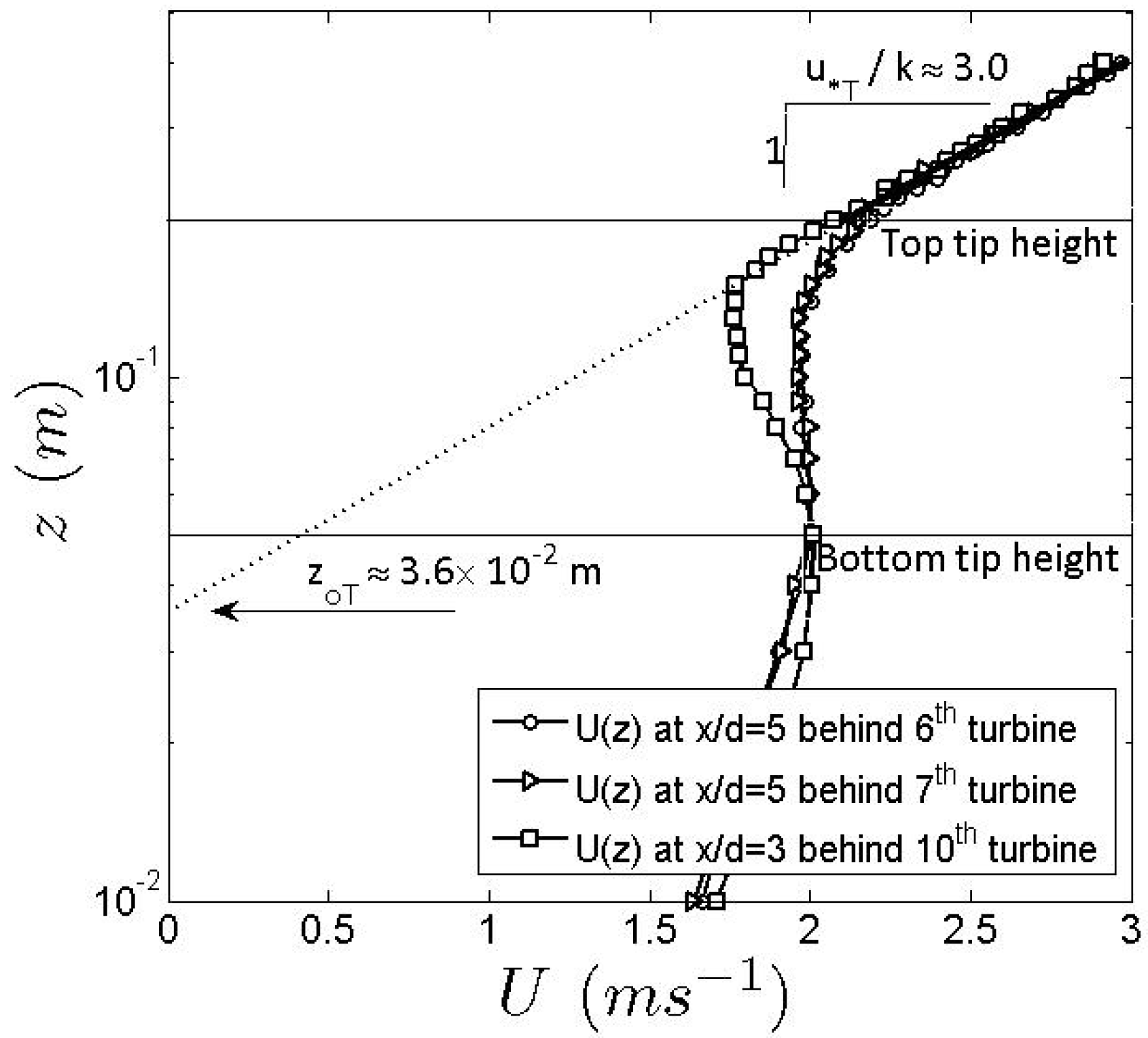In this section we present flow statistics at different locations inside and above the model wind farm at zero span (see
Figure 1) considering two layouts (
= 5 and 7 with
= 4). Emphasis is placed on the distribution of normalized mean velocity,
(where
is the mean velocity at the turbine hub height), turbulence intensity,
, kinematic shear stress,
and other properties such turbulence energy production,
, and velocity spectra.
3.1. Mean Velocity Distribution
Mean velocity distribution around the wind farm for the case
= 5 and
= 4 is depicted in
Figure 2. Based on the downwind distance required to reach nearly adjusted statistics, our results suggest that the flow can be divided in two broad regions. The first region is located below the wind farm top tip height and has a direct effect on the performance of the wind turbines. In that region, the mean flow appears to reach equilibrium as close as the third to fourth wind turbine row. The second region is located right above the first region and flow adjustment is slower.
Figure 2.
Non-dimensional distribution of mean velocity around the wind farm with (top) and normalized angular velocity distribution of the different wind turbines with and (bottom). Dots indicate measurement locations.
Figure 2.
Non-dimensional distribution of mean velocity around the wind farm with (top) and normalized angular velocity distribution of the different wind turbines with and (bottom). Dots indicate measurement locations.
The fast velocity adjustment observed below the turbines top tip (hereon region I) is responsible for the relatively quick adjustment of the wind-turbine angular velocities as close as the third row of turbines in the wind farm (see
Figure 2). Indeed, minor changes of angular velocity are observed after the third-fourth row of wind turbines for each of the two layouts considered (
= 5 and 7). The differences observed in the distribution of angular velocity in the two cases (roughly 8%) suggest that the total power of the wind farm is very sensitive to the geometrical layout. Selected vertical velocity profiles at
= 2 behind the third, fourth and the fifth row of wind turbines, shown in
Figure 3, reveal the fast adjustment of the mean velocity below the top tip height. In contrast, above the top tip (hereon region II) velocity profiles appear to be far from equilibrium, evidencing different mechanisms of mixing and transport of the mean flow between the two regions.
Figure 3.
Normalized streamwise velocity component distribution (left) and its deficit (right) in the wind farm.
Figure 3.
Normalized streamwise velocity component distribution (left) and its deficit (right) in the wind farm.
The non-axisymmetric shape of the velocity profile observed in region I, induced by the boundary layer (see
Figure 3a, complicates its parameterization. As pointed out by Chamorro and Porté-Agel [
25], the mean velocity deficit
in the wake of a single wind turbine placed in a boundary layer flow is approximately axisymmetric. Due to the interaction of the multiple (superimposed) wakes and the boundary condition imposed by the surface, which limits the wake expansion, the velocity deficit (
) is not strictly symmetric below the bottom tip and above the top tip heights. Between those heights, the velocity deficit shows a reasonable symmetric shape.
Although different approaches have been proposed to estimate the mean velocity inside a wind farm, they unfortunately do not fully consider the boundary layer effects. Similar to the velocity deficit formulation downwind of a single wind turbine, suggested by Chamorro and Porté-Agel [
25], the velocity deficit in an aligned wind farm can bee described by
where
is the velocity deficit in the wake of the
row of wind turbines,
is its counterpart at the hub height,
r is the distance from the center of the wake and
R is the characteristic width of the wake at distance
x downwind of the rotor. Because the mean velocity adjusts relatively fast (see
Figure 2), Equation (
1) becomes quickly independent of the relative position
i in the farm.
Figure 4 shows clearly that the mean velocity above the top tip height (region II) adjusts far inside the wind farm. The velocity appears to reach equilibrium starting from the sixth row of wind turbines, and upwind of this location, the flow is transitioning. The relative location where the flow reaches equilibrium is of special importance. For instance, large-scale atmospheric models require the specification of the additional surface roughness induced by a wind farm. That parameter should be obtained under equilibrium conditions, where similarity theory can be applied. In general, a departure of the log-law velocity distribution is expected downwind of a surface roughness transition. Indeed, both mean velocity and surface shear stress adjust slowly downwind of a transition [
27,
28]. Because the transition zone appears to be significant in the wind farm (6–7 turbine rows), its characterization is relevant in the understanding of the interaction between the wind farm and the boundary layer, which ultimately modulates the power available for the wind turbines.
Figure 4.
Non-adjusted (left) and adjusted (right) velocity distributions above the top tip in the wind farm at different locations (). Horizontal lines represent the turbine bottom and tip heights.
Figure 4.
Non-adjusted (left) and adjusted (right) velocity distributions above the top tip in the wind farm at different locations (). Horizontal lines represent the turbine bottom and tip heights.
A representative characterization of the mean flow at the bottom tip, hub, and top tip heights in region I throughout the wind farm is given in
Figure 5. From that figure it is clear that the momentum recovery between the wind turbines is insufficient, especially in the case of
= 5. The velocity at the bottom and at the top tip heights shows much less variation. The mean flow appears to be more uniform directly upstream of each turbine in the case of
= 7. Again, this effect remarks the importance of wind farm layout in the overall wind farm performance.
Figure 5.
Normalized streamwise velocity component distribution in the wind farm. (top) and (bottom).
Figure 5.
Normalized streamwise velocity component distribution in the wind farm. (top) and (bottom).
3.2. Turbulence Intensity Distribution
In general, turbulence intensity in the wake of a wind turbine,
, comes from two main sources: the background turbulence,
, and the wake added turbulence,
. They are related in the following way:
Several empirical expressions have been proposed to estimate the added turbulence intensity
[
29,
30,
31]. Recently, Chamorro and Porté-Agel [
24] showed that the use of a single value to represent the wake-averaged added turbulence intensity is not sufficient due to its high spatial variability. In a simple attempt to include the non-axisymmetric effects, Chamorro and Porté-Agel [
24] propose to differentiate between a positive change (increase)
, which occurs at the upper part of the wake, and a negative change (decrease)
in the lower part of the wake.
For a wind farm configuration where multiple turbine wakes coexist, Frandsen and Thogersen [
32] proposed a model that considers the wind farm layout. It is based on the geostrophic drag law and takes into account the additional surface roughness generated by the turbines:
where
Here
is the thrust coefficient,
and
s are the inter-turbine spacings (normalized by the rotor diameter) within a row and between rows, respectively. The Frandsen and Thogersen [
32] model applies above the hub height, and has become the European standard.
An alternative model, proposed by Wessel and Lange [
33], assumes that the overall turbulence intensity at a particular location in the wind farm is given by:
where
N is the number of upwind turbines from the location of interest (
x) and
is the added turbulence intensity contribution of the
turbine at location
x.
Although these models determine a unique representative value for the turbulence intensity in the wind farm, they show fundamental differences. The first approach assumes that turbulence levels do not change with the number of turbines in the wind farm, while the second approach assumes a monotonic increase with the downwind distance in the wind farm. The structural differences given by these approaches point out that, to date, there is no consensus model for the prediction of turbulence intensity inside wind farms [
5].
Our results (
Figure 6) show that turbulence intensity significantly increases in the first three-four rows of wind turbines and, after the fifth row, it appears to reach a plateau, which differs from the Wessel and Lange [
33] model (monotonically positive growth).
Figure 6.
Turbulence intensity distribution around the wind farm. = 5 (top) and = 7 (bottom). Dots indicate measurement locations.
Figure 6.
Turbulence intensity distribution around the wind farm. = 5 (top) and = 7 (bottom). Dots indicate measurement locations.
Significant differences in the spatial distribution of the turbulence intensity are observed behind a single wind turbine and far inside the wind farm. For instance, from
Figure 6 an enhancement of roughly 50% in turbulence intensity is observed between these two situations. Also, an increase of the turbulence levels at the bottom tip height is clearly observed inside the wind farm.
Figure 6 also shows that, after the second row of wind turbines, the peak of turbulence intensity is consistently located near the top tip height at roughly three rotor diameters downwind of each turbine (
≈ 3). This peak is closer than that observed in a single wind turbine. Wind tunnel experiments performed by Chamorro and Porté-Agel [
25] and corresponding large-eddy simulations by Wu and Porté-Agel [
34] have shown that maximum values of turbulence intensity in the wake of a single wind turbine are located at a distance of 4 to 5.5 rotor diameters under neutral stratification. Other recent LESs of field turbine wakes show a similar turbulence intensity enhancement at the top tip level, with a maximum value at a downwind distance of about 2–3 rotor diameters [
35].
The comparison of the two layouts (
= 5 and
= 7) reveals that the distribution of turbulence intensity in the vicinity of each wind turbine depends also on the separation between turbines (
).
Figure 7 shows the turbulence intensity at the bottom tip, hub, and top tip heights. It is clearly observed that in both cases the local maximum of turbulence intensity is located around top tip with a peak at a normalized distance of
≈ 3.
Figure 7.
Turbulence intensity distribution in the wind farm at bottom, hub and top tip heights. = 5 (top) and = 7 (bottom).
Figure 7.
Turbulence intensity distribution in the wind farm at bottom, hub and top tip heights. = 5 (top) and = 7 (bottom).
The gradual adjustment of the mean velocity observed in region II (see
Figure 2) is also evident in the case of the turbulence intensity distribution depicted in
Figure 6. There, the turbulence intensity gradually transitions to higher levels with downwind distance, forming a clear layer with enhanced turbulence. This is expected since the wake expansion, above the top tip level, and the superposition of multiples wakes produce higher velocity fluctuations.
In order to appreciate the relative location of this layer, turbulence intensity is plotted in
Figure 8 at several heights (1.25
H; 1.5
H and 2
H, where
H is the turbine height) for the two layouts. From that figure, two distinct layers can be distinguished. One layer, an internal boundary layer, is modulated by the interaction between the wind farm and the incoming boundary layer flow. Within the other layer, an equilibrium layer, flow statistics are adjusted to the new conditions imposed by the wind turbines. A schematic of these layers is depicted in
Figure 9.
Figure 8.
Turbulence intensity distribution at different heights above the wind farm. (a) z = 1.25 H; (b) z = 1.5 H; (c) z = 2 H. H = turbine height.
Figure 8.
Turbulence intensity distribution at different heights above the wind farm. (a) z = 1.25 H; (b) z = 1.5 H; (c) z = 2 H. H = turbine height.
Figure 9.
Conceptual description of the different regions and layers in a wind farm.
Figure 9.
Conceptual description of the different regions and layers in a wind farm.
These characteristic layers are always present in the atmospheric boundary layer after a surface roughness transition. Because velocity and turbulent fluxes are highly modified after a surface transition, accurate parameterizations are of special relevance in large-scale atmospheric models (e.g., weather prediction models). The clear existence of these two layers above the wind farm suggests that, from a large-scale perspective, a finite-size wind farm can be treated as a special case of roughness transition.
3.3. Other Flow Statistics
Spatial distribution of normalized kinematic shear stress,
, is shown in
Figure 10 for the case
= 5. An important enhancement of the turbulent stresses is observed up to roughly the fourth row of wind turbines. The enhancement of turbulent stresses is higher with respect to the case of a single turbine scenario (as observed between the first and second wind turbine). Similar to the case of the mean velocity and turbulence intensity, both an internal and equilibrium layer are observed in region II.
Figure 10.
Non-dimensional distributions of kinematic shear stress (top) and turbulent kinetic energy production (bottom) inside and above a 10-turbines wind farm ( = 5).
Figure 10.
Non-dimensional distributions of kinematic shear stress (top) and turbulent kinetic energy production (bottom) inside and above a 10-turbines wind farm ( = 5).
Similar to the case of turbulence intensity (
Figure 8),
Figure 11 shows the adjustment of the kinematic shear stress in region II with distance at different heights. Both an internal boundary layer and an equilibrium layer are clearly observed. Their specific locations, at a given height, agree with those observed for the turbulence intensity. As expected, high levels of kinematic shear stress are observed closer to the wind turbines.
Figure 11.
Non-dimensional distribution of kinematic shear stress at different heights above the wind farm. (a) z = 1.25 H; (b) z = 1.5 H; (c) z = 2 H. H = turbine height.
Figure 11.
Non-dimensional distribution of kinematic shear stress at different heights above the wind farm. (a) z = 1.25 H; (b) z = 1.5 H; (c) z = 2 H. H = turbine height.
Areas of greater turbulence energy production (
component) through the wind farm, shown in
Figure 10, are consistent with the enhanced levels of turbulence intensity observed above the hub height. Its maximum values are located between one and three rotor diameters downwind of each turbine.
It is important to notice that the highest levels of turbulent kinetic energy production and turbulence intensity do not coincide with the location of the different wind turbines (which normally are 5 to 7 rotor diameters apart). An enhancement of the turbulence energy production is observed also at the bottom tip height for the different wind turbines.
In general, turbulence characteristics at the turbine top tip height are of special relevance. They give insights on the interaction between regions I and II. In particular, from the pdf of the streamwise velocity component at a relative distance
= 3 (
Figure 12) it is possible to see the adjustment of the flow. It is noted that for the first four wind turbines the velocity distribution is clearly not adjusted.
Figure 12.
P.d.f. of streamwise velocity component at top tip height inside the wind farm ().
Figure 12.
P.d.f. of streamwise velocity component at top tip height inside the wind farm ().
Power spectra of the streamwise and vertical velocity components reveal important effects of the flow turbulence on the helicoidal tip vortices (see
Figure 13). In particular, it is observed that behind the first wind turbine, where the background turbulence is relatively low, tip vortices induce a strong signature on the spectrum at a frequency coincident with that of the consecutive blades. Velocity spectrum of the vertical velocity component shows a stronger signature of the tip vortices compared with the streamwise velocity spectrum (see also [
27]).
Figure 13.
Power spectrum of the streamwise (u) and vertical (w) velocity components at top tip height inside the wind farm. (a) u-component at = 1 behind the 1st turbine ( = 5); (b) w-component at = 1 behind the 1st turbine; (c) u-component at = 1 behind the 10th turbine ( = 5); (d) w-component at = 1 behind the 10th turbine ( = 5); (e) u-component at = 1 behind the 10th turbine ( = 7); (f) w-component at = 1 behind the 10th turbine ( = 7).
Figure 13.
Power spectrum of the streamwise (u) and vertical (w) velocity components at top tip height inside the wind farm. (a) u-component at = 1 behind the 1st turbine ( = 5); (b) w-component at = 1 behind the 1st turbine; (c) u-component at = 1 behind the 10th turbine ( = 5); (d) w-component at = 1 behind the 10th turbine ( = 5); (e) u-component at = 1 behind the 10th turbine ( = 7); (f) w-component at = 1 behind the 10th turbine ( = 7).
Far inside the wind farm, at a relative distance of = 1 (i.e., behind the tenth wind turbine), it is possible to notice that, due to the relatively high levels of velocity fluctuations inside the wind farm (case = 5), tip vortices have negligible effects on the streamwise velocity component and minimum effects on the vertical velocity component. On the other hand, the slightly lower turbulence levels around the turbines in the case of = 7 lead to non-negligible signatures of the tip vortices in the power spectrum of both velocity components.
3.4. Wind Farm Roughness
The idea of representing a large wind farm as an added surface roughness to study local meteorology effects in large-scale atmospheric models has gained attention in the last decade [e.g.,
9,
36]. From this perspective, and as a first approximation to the problem, wind turbines in a wind farm can be treated as localized roughness elements.
An early formulation to estimate the aerodynamic roughness length induced by evenly spaced obstacles of similar height and shape was proposed by Lettau [
37]. It states:
where
is the average vertical extent (or effective obstacle height),
s the area of the obstacle measured in the vertical crosswind-lateral plane and
S is the horizontal area per obstacle.
The application of this formulation to the case of a large wind farm requires adjustments of the different terms. The characteristic constant (0.5) represents the average drag coefficient of a characteristic individual obstacle. From the actuator disc momentum theory (see Burton
et al. [
5]), that constant is
, where
a is the induction factor. The obstacle (wind turbine) area is
and
. Then, Lettau’s formula for estimating the wind farm roughness can be written as:
It is important to notice the coherent behaviour of Equation (
7). For instance, if the turbines are not in operation (
i.e., no motion) their effect on the total roughness should be negligible, which is consistent with Equation (
7) by setting
a = 0 (no motion) but not with the original formulation. A combined roughness of the ground and a wind farm was proposed by Frandsen [
38]. In that model
where
is the surface roughness of the area of the wind turbine cluster,
h is the turbine hub height,
, where
is the thrust coefficient.
In this experiment, the characteristic surface roughness of the model wind farm was obtained from the adjusted logarithmic region,
i.e., starting from the sixth row of wind turbines. A schematic of the calculation is shown in
Figure 14. There, a value of
= 3.6 × 10
m was found for the case
= 5, which is roughly four times higher than that predicted by Equations (
7) and (
8). The departure between the measured and predicted value of the wind farm roughness highlights the intrinsic difficulties of its parameterization. It should also be noted that one factor that could contribute to the overestimation of the wind farm roughness is the fact that it is based on measurements collected only at the center plane (
y = 0). Recent large-eddy simulations of the same flow have shown that, for that wind farm configuration, including spanwise variability leads to smaller roughness estimates [
35]. Future research will address this issue using both LES and additional wind-tunnel experiments.
Figure 14.
Aerodynamic roughness length of the wind farm array for the case = 5.
Figure 14.
Aerodynamic roughness length of the wind farm array for the case = 5.
